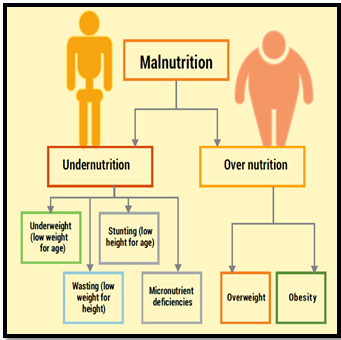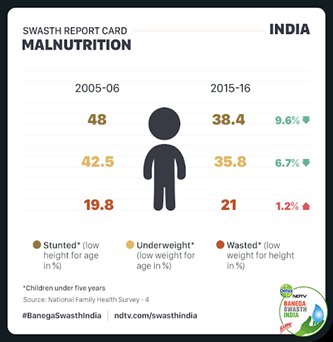EARLY NUTRITION AND COGNITIVE DEVELOPMENT
Syllabus:
- GS 2 : Issues related Women and Children
Focus:
- Early childhood stunting not only affects a child’s height but also impacts cognitive development significantly.
- Despite recognition of its long-term effects, the mechanisms linking stunting to lower cognitive achievements, especially in low- and middle-income countries, are not fully understood.
Insights from Recent Study:
- Research conducted in Ethiopia and Peru reveals the negative impact of stunting on cognitive abilities later in childhood.
- Stunting at around age 5 correlates with reduced executive functioning, even after accounting for household fixed effects.
- The study suggests that stunting may affect working memory as early as age 5, influenced by vocabulary development, highlighting the importance of early nutrition.
- Research often focuses on specific cognitive-achievement test scores, which may not fully capture inherent cognitive skills.
- Traditional achievement tests, influenced by both cognitive abilities and educational access, can be complex and potentially misleading in assessing cognitive skills.
Source: Dics.co
Understanding Malnutrition- Nutrition Problem in India:
| Key Terms
Malnutrition: Malnutrition refers to deficiencies, excesses, or imbalances in a person’s intake of energy and nutrients. It encompasses both undernutrition (insufficient intake) and overnutrition (excessive intake) of nutrients, leading to adverse health effects. Stunting: Stunting is a form of under nutrition characterized by impaired growth and development in children, usually resulting from chronic malnutrition during the early years of life. It leads to shorter than average height for age. Wasting: Wasting, also known as acute malnutrition, is characterized by rapid weight loss or failure to gain weight, often accompanied by muscle and fat loss. It typically indicates recent or severe undernutrition and is measured by weight for height. Body Mass Index (BMI): Body Mass Index is a measure of body fat based on a person’s weight and height. It is calculated by dividing weight in kilograms by height in meters squared. BMI is used to assess nutritional status and classify individuals into underweight, normal weight, overweight, or obese categories. |
- Targets to Curb Malnutrition:
- Aims to reduce stunting and under-nutrition among children below 6 years by 2% annually.
- Targets a 2% annual reduction in low birth weight and a 3% annual decrease in anemia among children aged six to 59 months, as well as women and adolescent girls aged 15 to 49 years.
- Malnutrition Data:
- Meghalaya and Bihar have the highest prevalence of stunted children at 46.5% and 42.9% respectively.
- Maharashtra has the highest percentage of wasted children at 25.6%, followed by Gujarat at 25.1%.
- Jharkhand has the highest percentage of women (15-49 years) with below-normal Body Mass Index (BMI) at 26%.
- Stunting decreased from 38.4% to 35.5%, wasting reduced from 21.0% to 19.3%, and underweight prevalence declined from 35.8% to 32.1%.
- The percentage of women (15-49 years) with below-normal BMI decreased from 22.9% in NFHS-4 to 18.7% in NFHS-5.
Source: NDTV
Key Initiatives taken By Government:
Anaemia Mukt Bharat Abhiyan:
- Launched in 2018, aims to accelerate the decline of anemia rates by one to three percentage points annually.
- Focuses on combating anemia through awareness, screening, and supplementation programs.
Mid-day Meal (MDM) Scheme:
- Aims to enhance nutritional levels among school children, positively impacting school enrollment, retention, and attendance.
- Provides hot cooked meals to children in government and government-aided schools.
POSHAN Abhiyaan:
- Launched as the National Nutrition Mission (NNM), aims for a “Malnutrition Free India” by 2022.
- Seeks to address malnutrition through targeted interventions and awareness campaigns.
National Food Security Act (NFSA), 2013:
- Ensures food and nutrition security for vulnerable populations by making access to food a legal right.
- Provides subsidized food grains to eligible households through the Public Distribution System (PDS).
Pradhan Mantri Matru Vandana Yojana (PMMVY):
- Provides financial assistance of Rs. 6,000 directly to the bank accounts of pregnant women.
- Aims to ensure better maternal health and nutrition during pregnancy and childbirth.
Integrated Child Development Services (ICDS) Scheme:
- Launched in 1975, provides a range of services including food, preschool education, healthcare, and immunization to children under 6 years and their mothers.
- Focuses on holistic child development and maternal health through community-based interventions.
Way Forward / Key Strategies for Improvement:
- Promoting Early Breastfeeding:
- Expansion of programmes like the Mother’s Absolute Affection (MAA) Programme to provide lactation support and education about exclusive breastfeeding.
- Encourage exclusive breastfeeding for six months and continued breastfeeding for two years, supplemented with appropriate complementary feeding.
- Leveraging mobile technology for maternal education on breastfeeding’s critical role in infant health.
- Diversifying Child’s Diet:
- Scaling up community-based complementary feeding programmes to educate parents about adding nutrient-rich foods to their child’s diet after six months.
- Focus on locally available, nutrient-rich food options for optimal child nutrition.
- Enhancing Early Childhood Education:
- Adding an additional Anganwadi worker to each centre to improve preschool instructional time and overall child development.
- Evidence suggests that increased staff can improve maths and language scores while reducing child stunting and malnutrition.
- Studies suggest this approach enhances developmental outcomes and creates employment opportunities.
- Enhancing Financial Commitments
- Increased investment in women and children’s health and nutrition is vital for their sustainable development and improved quality of life.
- Outcome-driven Approach:
- India should adopt an outcome-oriented approach to nutrition programmes, focusing on direct engagement with vulnerable groups like the elderly, pregnant women, and young children.
- Last-mile delivery of key nutrition services and interventions must be ensured.
- Promoting Basic Education and Awareness:
- Mothers’ education is linked to improved access and compliance with nutrition interventions among children.
- Prioritizing nutrition and health is essential to give the young population competitive advantage.
- Monitoring and Evaluating Programmes:
- Establishing robust monitoring and evaluation mechanisms is crucial to address systemic challenges and ensure effective implementation of schemes.
- Regular review of nutritional status across states is necessary to make informed policy decisions and improve programme effectiveness.
Addressing early childhood nutrition comprehensively through these strategies can significantly improve cognitive development outcomes in children and contribute to a healthier future generation in India.
Source:
Mains Practice Question:
Elaborate on the challenges and initiatives undertaken by the government to address malnutrition in India.

 Source: Dics.co
Source: Dics.co Source: NDTV
Source: NDTV

